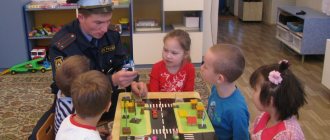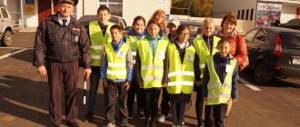Presentation “Ensuring personal safety on the roads”
Ensuring personal safety on the roads
Road traffic
- a set of social relations that arise in the process of moving people and goods with or without vehicles within the boundaries of roads.
Road traffic is governed by traffic rules, which include both a body of law and informal rules that develop over time.
Organized road traffic has a well-developed system of travel priorities, markings and a system of signs, and means of regulating flows at intersections.
Traffic Laws
Traffic Laws
(abbreviated as: traffic rules) - a set of rules governing the responsibilities of road users (vehicle drivers, passengers, pedestrians, etc.), as well as technical requirements for vehicles to ensure road safety.
Road sign
Road sign
- a technical means of road safety, a standardized graphic design installed near the road to convey certain information to road users.
Although the general principles of road signs and symbols are the same in many countries, the signs themselves can vary quite a bit from country to country. In fact, most of the world's road sign systems can be reduced to two systems, European and Anglo-Saxon, with some local additions and differences. In Europe, Russia and many other countries of the world, the Vienna Convention on Road Signs and Signals is in force.
Road signs
1. Warning signs
Warning signs inform drivers that they are approaching a dangerous section of the road, driving along which requires taking measures appropriate to the situation.
2. Priority signs
Priority signs establish the order of passage through intersections, intersections of roadways or narrow sections of the road.
3. Prohibition signs
Prohibition signs introduce or remove certain traffic restrictions.
4. Mandatory signs
5. Signs of special regulations
Special regulations signs introduce or cancel certain traffic modes.
6. Information signs
Information signs inform about the location of populated areas and other objects, as well as established or recommended traffic modes.
7. Service marks
Service signs inform about the location of the relevant facilities.
8. Additional information signs (plates)
Additional information signs (plates) clarify or limit the effect of the signs with which they are used.
Horizontal marking
Horizontal markings (lines, arrows, inscriptions and other markings on the roadway) establish certain modes and order of movement.
Horizontal markings can be permanent or temporary. Permanent markings are white except for lines 1.4
,
1.10
and
1.17
yellow, temporary - orange.
Vertical marking
Vertical markings in the form of a combination of black and white stripes on road structures and elements of road equipment show their dimensions and serve as a means of visual orientation.
Road traffic accident
Traffic accident
(
road accident
) - an event that occurred during the movement of a vehicle on the road and with its participation, in which people were killed or injured, vehicles, structures, cargo were damaged, or other material damage was caused.
Traditionally, the list of “factors hazardous to driver health” includes:
violation of traffic rules, including: alcohol intoxication;
exceeding the permissible speed limit; talking on a mobile phone;
failure to use seat belts;
using a defective vehicle;
driver fatigue (a driver who is very tired may fall asleep while driving).
conversation with passengers;
smoking while driving
etc.
The main damaging factors in an accident
- dynamic shock caused by the vehicle stopping almost instantly
- injury from debris and vehicle parts
- long-term compression syndrome when victims are pinched by parts of vehicles
- exposure to high temperatures and released gases in the event of a fire
- exposure to hazardous substances with the participation of special vehicles transporting dangerous goods
Accident classification
- collision
- capsize
- hitting a stationary vehicle
- hitting an obstacle
- collision with a pedestrian
- hitting a cyclist
- collision with a horse-drawn vehicle
- hitting an animal
- passenger fall
- other types of accidents (incidents not related to the above types)
Road user
- a person directly involved in traffic as a driver, pedestrian, or passenger of a vehicle. In law enforcement practice, the term “road user” is sometimes mistakenly interpreted too broadly and road users are understood as police officials who regulate traffic, and other persons united by the concept of “traffic controller”, as well as persons directly related to the performance of any work on the road (roadway repair, marking, snow removal, etc.). The rights and obligations of these persons are determined by the relevant departmental instructions, the requirements of which must be based on the Traffic Rules and not contradict them
General safety measures that a pedestrian must observe.
- When leaving the entrance of the house, pay attention to whether a car, motorcycle, moped, or bicycle is approaching you.
- If there is a car parked near the house or trees growing, blocking your view, before entering the roadway, look around to see if there is a moving vehicle behind the obstacle.
- When driving on the sidewalk, always stay on the right side to avoid interfering with oncoming pedestrian traffic or obstructing traffic.
- When walking along the sidewalk past a gate or garage exit, you need to pay attention to whether a car is leaving.
- When preparing to cross the road, you need to inspect the roadway
Rules of conduct when using trams, buses and trolleybuses.
- Wait for a bus, trolleybus, tram only on the landing platform, and where there is none, on the sidewalk or side of the road.
- When boarding a tram, if the tram tracks are located in the middle of the street, cross the roadway after the tram stops.
- Before crossing, you need to inspect both sides of the road in the absence of moving traffic. Boarding must be done through the front doors, and disembarking must be done through the rear doors or through doors marked “Exit”.
Class hour on traffic rules for schoolchildren in grades 7-8 with presentation
Class hour scenario “Traffic rules for grades 7-8: for road safety”
Author: Veshnikova E.V., teacher of the Yuzhno-Aleksandrovskaya Secondary School No. 5, Ilansky district, Krasnoyarsk Territory. Goal: systematize students’ ideas about road safety rules and accident prevention. Objectives: 1. Systematize students’ existing ideas about road safety rules and the dangers of non-compliance with traffic rules on the roads. 2. Develop logical thinking and speech competencies of students. 3. Foster a culture of behavior on the roads, contribute to the development of valeological and communicative culture among students. Time: 1 class hour. Motto: Know the rules of movement like the multiplication table! (On the desk). Educational and visual complex: PC, multimedia projector, screen, flashcards, traffic rules posters, red, yellow and green tokens. Author's media product: multimedia presentation. Purpose: creating conditions for the formation and development of students' intellectual and practical knowledge of traffic rules, the ability to independently acquire and apply this knowledge in life. Practical significance of the development: this scenario can be recommended to teachers, students of pedagogical universities, colleges as a source of information when preparing for extracurricular activities on this topic. Stages of the class hour 1. Organizational moment. 2. Study and mastery of new material. 3. Generalization and systematization of knowledge. 4. Summing up. Reflection. Progress of the class hour Students are divided into 2 teams in advance. 1. Organizational moment. Organizing students' attention. Next, the teacher asks a riddle: - There are houses in two rows, Ten, twenty, a hundred in a row. And with square eyes they look at each other (street) . To help you pass the dangerous path, Both day and night are lit - Green, yellow, red... (traffic light) . Students solve the riddle, then the teacher names the topic of the class hour and invites students to independently name its purpose. 2. Study and mastery of new material. Teacher: Guys, today we will talk once again about the rules of the road, and, therefore, about the most important thing - how to avoid accidents and maintain health for many years... Modern streets of cities and towns are filled with cars. Systematic chaos, disorderly traffic on the roads would make our life unsafe, cars would constantly run into people and collide with each other, and the ambulance would not be able to keep up with everyone in need if there were no traffic police. The State Traffic Inspectorate of the Ministry of Internal Affairs of Russia (STSI) is a unit within the structure of the Ministry of Internal Affairs of the Russian Federation that carries out control, supervisory and licensing functions in the field of ensuring road safety (slide 2). Student 1: Unfortunately, traffic accidents do happen on the roads. -Cross the road There are many reasons: Either with ice cream at the kiosk, Or a kitten, or a watchdog. But for the sake of the octopus, don’t run across the road. (O. Emelyanova) Road accident is an event that occurred during the movement of a vehicle on the road and with its participation, in which people were killed or injured, vehicles, structures, cargo were damaged, or other material damage was caused (slide 3). Student 2: Classification of traffic rules: collision, rollover, collision with a standing vehicle, collision with an obstacle, collision with a pedestrian, collision with a cyclist, collision with a horse-drawn vehicle, collision with an animal, other types of accidents (incidents not related to the above types) (slide 4). Student 3: But there would probably have been much more accidents if there were no traffic lights. The first traffic light was installed on December 10, 1868 in London near the British Parliament building. And the first recorded accident in history occurred on May 30, 1896 in New York: Henry Wells’ electric car collided with Evelyn Thomas’s bicycle, the cyclist escaped with a broken leg (slide 4). Student 2: Today, the main risk factors on the roads are ignorance or violation of traffic rules, operation of faulty vehicles, non-use of seat belts by vehicle passengers, and careless attitude towards the performance of their duties by vehicle drivers (slide 6). Next is a physical exercise (game “Traffic Light”): the teacher shows a red token - students stand, a yellow one - they clap their hands, a green one - they stomp their feet. Student 1: The most unpleasant hours for meeting pedestrians are from 12 to 20 hours. These hours account for the maximum number of victims in road accidents (slide 7). Student 3: A huge number of accidents involving children occur due to the fault of adults who do not follow road safety rules; they often transport minors without special restraints and seat belts. As a result, quite often children become hostages of the carelessness of adults. Children are allowed to ride in the front seat of a car from the age of 12. What are the percentages of road accidents? Road accidents occur: due to violation of traffic rules by vehicle drivers - 85%. Due to traffic violations by pedestrians - 20.15%. Due to the unsatisfactory condition of streets and roads - 20.99%. Due to the operation of technically faulty vehicles - 0.57% (slide 8-9). Student 2: Criminal or administrative liability of a driver arises in cases where the driver’s actions contain elements of an administrative offense or a crime (usually committed through negligence). In both the first and second cases, grounds for civil liability may arise - obligations to compensate for the harm caused (slide 10). Student 1: Remember, to avoid trouble on the roads, you should: o Cross the street only when the traffic light is green. o Always allow vehicles with their special lights on to pass. o Do not cross the roadway in front of nearby vehicles. o While waiting for transport, stand only on landing areas or the side of the road. o Do not pass around a stationary car - it is dangerous. Wait until he drives away. o Approach boarding only after the vehicle has come to a complete stop. o If there is no sidewalk, you need to walk along the side of the road towards moving traffic (slide 11). Student 2: - We give the guys a warning: Learn the traffic rules urgently, So that parents don’t worry every day, So that drivers can rush along the street calmly! (Yu. Yakovlev) 3. Generalization and systematization of knowledge. A) Blitz survey (for the correct answer - 1 point): 1. How is PPP deciphered? (patrol service) . 2. What color is the top traffic light? (red) . 3. Paved roadway (highway) . 4. Place of intersection of roads (crossroads) . 5. What does a red traffic light mean? (stop, movement is prohibited) . 6. An optical device carrying light information, designed to regulate the movement of motor vehicles, as well as pedestrians at pedestrian crossings (traffic lights) . 7. Not alive, but walking, not moving, but leading (road) . 8. Emergency telephone number (03) . 9. A place where vehicles are left for a while (parking) . 10. At what age are children allowed to ride in the front seat of a car? (from 12 years old) (slide 12-31). Teacher: - To make the topic more interesting, it’s time for riddles. B) Riddle competition (for the correct answer - 1 point): 1. A house is walking down the street, It takes us to work, Not on thin chicken legs, But in rubber boots (a bus) . 2. The steering wheel is not for tea, but in the hands of the driver (steering wheel) . 3. This device identifies those who exceed the speed limit. A stern locator says: “There’s a violator on the road!” (radar) . 4. Look, what a strong man: on the move with one hand He’s used to stopping a five-ton truck (traffic controller) . B) “Did you know?” (for the correct answer - 1 point): 1. Which traffic light is turned on simultaneously for all sides of the intersection? (yellow) . 2. How and where should a pedestrian move if there is no sidewalk? (you need to walk along the side of the road towards moving traffic). 3. Is it possible to transport unsheathed skis or skates? (No) . 4. Are persons carrying out road work pedestrians? (No) . D) “Burim” (for a correctly (meaningfully) written quatrain – 2 points). The groups are given words and need to compose a quatrain: For the “Traffic Light” group: car, dust, car, tire. To the “SDA” group: people, forward, red light, no way. E) Competition “Solve the problem” , teams are given educational cards (for the correct answer - 2 points): Task for the group “Traffic Light” Three girls and two boys left the school building. When the schoolchildren approached the pedestrian crossing, the green traffic light had already begun to flash. The boys ran across the road, and the girls remained waiting for the next traffic light. Did the girls or boys do the right thing in this situation? Why? Task for the traffic rules group: Seven teenagers were playing ball on the roadway. Two of them soon went home. The rest stayed to play. Which of the teenagers did the right thing in this case? Why? 4. Summing up. Reflection. Teacher: - Guys, why do you think we took the catchphrase as the motto of the class hour: know the rules of movement like the multiplication table! (students answer the teacher’s question). - Well done, you completed all the tasks! Next, reflection is a discussion with students not only about what worked (or not), but also about what students would like to do again and what to do differently. Electronic manuals: 1. Great Encyclopedia of Cyril and Methodius, 2007. Presentation on the topic: Traffic rules for road safety
We recommend watching:
Lesson summary on traffic rules for schoolchildren in grades 5-6. Test on traffic rules with answers for students in grades 5-6 on the topic: Trolleybus and tram Speech by YID. Scenario Speech by the UID propaganda team on traffic rules in an elementary school
Similar articles:
Scenario of the speech of the YID propaganda team. Business card
Speeches by the propaganda team of the YID detachment. Scenario
Miniature according to traffic rules
Game - quiz with answers on traffic rules, grades 6-9
Propaganda brigade on traffic rules, grades 7-8. Scenario







